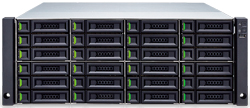RAID LEVELS
RAID LEVEL 50: JetStor RAID Level 50 Systems | RAID 5+0 Storage
RAID Level 50 requires a minimum of 6 drives to implement

Characteristics & Advantages
- RAID 50 should have been called "RAID 03" because it was implemented as a striped (RAID level 0) array whose segments were RAID 3 arrays (during mid-90s)
- Most current RAID 50 implementation is illustrated above
- RAID 50 is more fault tolerant than RAID 5 but has twice the parity overhead
- High data transfer rates are achieved thanks to its RAID 5 array segments
- High I/O rates for small requests are achieved thanks to its RAID 0 striping
- Maybe a good solution for sites who would have otherwise gone with RAID 5 but need some additional performance boost
Disadvantages
- RAID 5+0 is very expensive to implement
- All disk spindles must be synchronized, which limits the choice of drives
- Failure of two drives in one of the RAID 5 segments renders the whole array unusable




